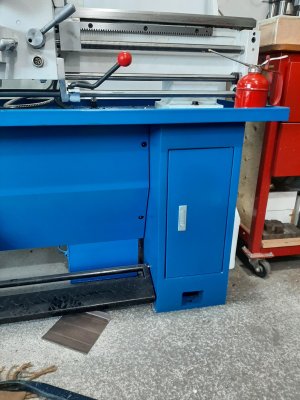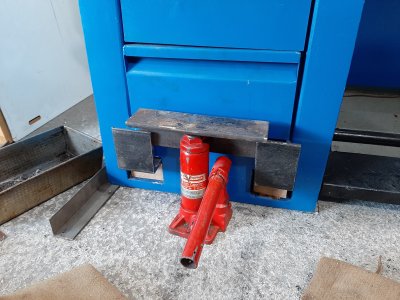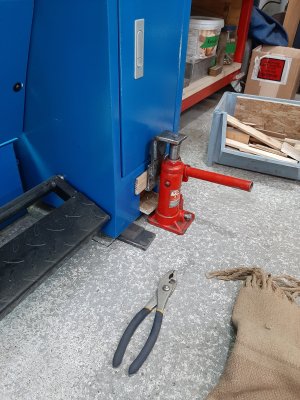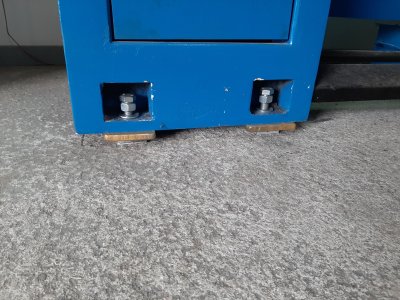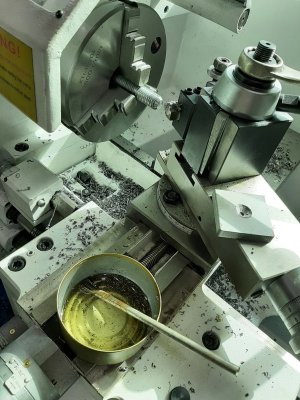Since the "researching lathes in Canada" thread has resulted in a purchase, I thought I might put general lathe questions in a new thread.
So, after making a few chips and exploring the new machine (PM1236 if you did not see the other thread), I figure it is time to "level" it. I have watched many of the popular youtubers and their levelling explanations and think I get it. I got a machinist level but that may have been a waste of money. Tooooo sensitive, I think but we will see. I am just getting going. After roughing the level in with a carpenter level, I find it is pretty good longitudinally, but tilts down in the front. I tried making some cuts in a 1.25 rod, chuck to center. Some videos show work piece between centers and some chuck to center and one no tail stock support. My initial cut was over .005 in about 20 inches. (and a crappy finish but my tool sharpening skill set could be a whole new discussion thread)
My real problem right now is how to lift this machine and stand to shim. I was able to lift the tail stock cabinet with a crowbar but the headstock it too heavy (working alone) I could get someone to put a shim in while I stand on the crowbar, but then I need to make another cut, scratch my head, do it again, etc so it could take a while and everyone is busy these days.
So, any input on leveling? I am considering making 4 plates to go under the 2 cabinets, incorporating adjustment screws into them. I would use 3/8" flat bar and span the width of the cabinet. The head stock cab would have two adjustments on each plate the tail end one (see photos)
But to lift the cabinet, (to shim or install a new plate if I make them) I am planning on making a tool to use a hydraulic jack as in photo. To keep the angle from pivoting down, there is just a piece of solid wood in the cavity, under the angle. What do you guys think? I don't think it is possible but wondering if forces would break the piece of cast out of the bottom of the stand. It is not designed to be loaded in that direction. I think without the wood, the jack would just pivot out. Or should I just get someone to stand by while I work my way around the machine and lift it up to some height whereby I can get an adjustment plate in there?
So, after making a few chips and exploring the new machine (PM1236 if you did not see the other thread), I figure it is time to "level" it. I have watched many of the popular youtubers and their levelling explanations and think I get it. I got a machinist level but that may have been a waste of money. Tooooo sensitive, I think but we will see. I am just getting going. After roughing the level in with a carpenter level, I find it is pretty good longitudinally, but tilts down in the front. I tried making some cuts in a 1.25 rod, chuck to center. Some videos show work piece between centers and some chuck to center and one no tail stock support. My initial cut was over .005 in about 20 inches. (and a crappy finish but my tool sharpening skill set could be a whole new discussion thread)
My real problem right now is how to lift this machine and stand to shim. I was able to lift the tail stock cabinet with a crowbar but the headstock it too heavy (working alone) I could get someone to put a shim in while I stand on the crowbar, but then I need to make another cut, scratch my head, do it again, etc so it could take a while and everyone is busy these days.
So, any input on leveling? I am considering making 4 plates to go under the 2 cabinets, incorporating adjustment screws into them. I would use 3/8" flat bar and span the width of the cabinet. The head stock cab would have two adjustments on each plate the tail end one (see photos)
But to lift the cabinet, (to shim or install a new plate if I make them) I am planning on making a tool to use a hydraulic jack as in photo. To keep the angle from pivoting down, there is just a piece of solid wood in the cavity, under the angle. What do you guys think? I don't think it is possible but wondering if forces would break the piece of cast out of the bottom of the stand. It is not designed to be loaded in that direction. I think without the wood, the jack would just pivot out. Or should I just get someone to stand by while I work my way around the machine and lift it up to some height whereby I can get an adjustment plate in there?

